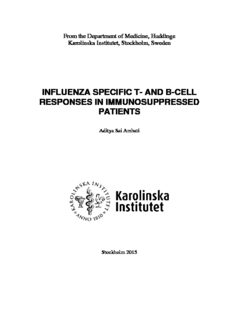
influenza specific t- and b-cell responses in immunosuppressed patients PDF
Preview influenza specific t- and b-cell responses in immunosuppressed patients
From the Department of Medicine, Huddinge Karolinska Institutet, Stockholm, Sweden INFLUENZA SPECIFIC T- AND B-CELL RESPONSES IN IMMUNOSUPPRESSED PATIENTS Aditya Sai Ambati Stockholm 2015 All previously published papers were reproduced with permission from the publisher. Published by Karolinska Institutet. Cover page – Depiction of pandemic influenza H1N1 virus, a single virion (hemagglutinin in blue, neuraminidase in pink and M2 protein in purple) and the epitope VEPGDKITFEATGNL (251-265 aa) on the hemagglutinin (influenza H1N1 images courtesy of CDC, USA and concept/design by Thomas Poiret and Aditya Ambati) Printed by E-Print AB 2015 © Aditya Sai Ambati, 2015 ISBN 978-91-7549-890-4 Influenza specific T- and B-cell responses in immunosuppressed patients THESIS FOR DOCTORAL DEGREE (Ph.D.) By Aditya Sai Ambati Principal Supervisor: Opponent: Prof. Per Ljungman Prof. Jorma Hinkula Division of Hematology Division of Virology Department of Medicine, Huddinge Department of Clinical and Experimental Karolinska Institutet Medicine Linköpings University Co-supervisor(s): Prof. Markus Maeurer Examination Board: Division of Therapeutic Immunology Prof. Ola Winqvist Department of Laboratory Medicine Division of Translational Immunology Unit Karolinska Institutet Department of Medicine, Solna Karolinska Institutet Prof. Marta Granström Department of Microbiology and Tumor Cell Biology Karolinska Institutet Doc. Britt-Marie Eriksson Division of Infectious Diseases Department of Medicine Uppsala University Dedicated to my family ABSTRACT Influenza, known as the ‘flu’, is a recurrent acute viral infection that might cause severe inflammation, particularly in vulnerable individuals, i.e. young children, the elderly, and immune-suppressed patients, such as stem cell transplant recipients. Prevention strategies, primarily vaccination, and possibly the use of anti-viral drugs, are recommended with the aim to reduce mortality and morbidity. Influenza vaccination responses are often sub-optimal in immune-compromised patients. There is therefore a need to evaluate other vaccination systems and schedules to improve vaccine efficacy. We mapped the humoral and cellular anti-flu directed immune responses and studied in a first set of experiments the immune responses in immune competent individuals prior to, and following a natural pandemic influenza infection, as well as after adjuvanted Pandemrix® influenza vaccination. This was performed prospectively during the H1N1 pandemic influenza of 2009. ‘High content’ influenza proteome peptide arrays were used to gauge serum IgG epitope signatures prior to and after Pandemrix® vaccination/ or H1N1 pandemic infection described in paper I. A novel epitope residing in the sialic acid receptor-binding domain of VEPGDKITFEATGNL (251-265) of the pandemic flu hemagglutinin was identified. This epitope was found to be exclusively recognized in serum from previously vaccinated individuals and never in serum from individuals with H1N1 infection. The natural H1N1 infection induced a different footprint of IgG epitope recognition patterns as compared to the Pandemrix® H1N1 vaccination. Pre-transplant influenza vaccination of the donor or allogeneic hematopoietic stem cell (HSCT) candidate was evaluated in a randomized study of 122 HSCT patients reported in paper II. The antibody titers against H1 (p=0.028) and H3 (p<0.001) were highest in the pre- transplant recipient vaccination group until d.180 after transplantation. A significant difference was found concerning the specific Ig levels against pandemic H1N1 at 6 months after HSCT (p=0.02). The mean IgG levels against pandemic H1N1, generic H1N1 and H3N2 were highest in the pre-transplant recipient vaccination group. Pre-transplant influenza vaccination of the donor or the HSCT candidate was found to be beneficial in eliciting seroprotective titers. The immunogenicity after a single dose of adjuvanted trivalent virosomal vaccination was evaluated in a cohort of 21 HSCT recipients and compared to a control cohort of 30 HSCT recipients who received a single dose of non-adjuvanted seasonal trivalent subunit vaccination, reported in Paper III. The delta change of IFNγ production in response to pandemic influenza H1N1 (p=0.005) and influenza B antigens (p=0.01) were significantly increased in blood from individuals who received the virosomal, as compared to the non- adjuvanted vaccine. Virosomal vaccination was found to be beneficial in eliciting robust cellular immune responses to influenza pandemic H1N1. Pandemic influenza hemagglutinin MHC class 1 peptide restricted CD8 T-cells were enumerated over the course of a natural pandemic influenza infection and Pandemrix® 3 vaccination in a prospective study reported in Paper IV. PBMCs from vaccinated control individuals exhibited a significantly increased percentage of (p=0.003) hemagglutinin specific CD8 T-cells that resided in the terminally differentiated effector memory compartment, as compared to PBMCs from individuals that contracted H1N1 infection. The cellular immune signatures were found to be different elicited by a natural flu infection as compared to vaccination concerning the phenotype/maturation of antigen-specific CD8 T- cells. 4
Description: